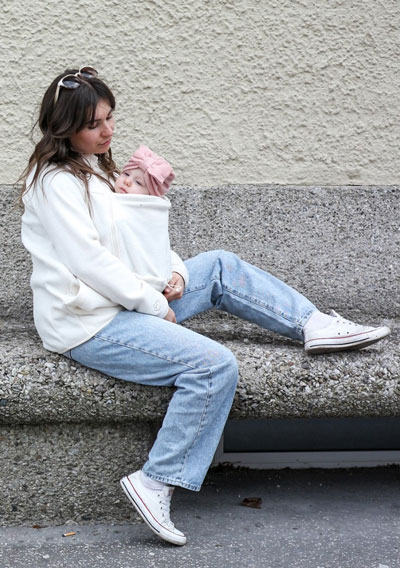Family hiking with a baby - babywearing expert & owner of DIDYMOS babywearing Tina Hofmann tells you how to do it
Have you always enjoyed being in nature? As a couple, you used to go hiking often, but you're not sure if and how you can continue your hobby with kids? Don't worry, there are many ways to continue enjoying nature together with your possibly very young baby.
That's exactly how it was for us when our son and later our daughter were born. For us, a close-fitting carrier like a baby carrier or a baby wrap was a perfect solution! We also had a backpack carrier (Kraxe), but later I will explain why it wasn't as popular with our children and us.
What are the advantages of using a baby wrap or baby carrier for hiking (and beyond)?

- Closeness and security: You carry your baby in a wrap or carrier directly on your body, so they can feel the warmth, heartbeat, and smell of mom or dad. This creates a strong bond and gives your baby a sense of security and comfort. And you feel how your baby is doing, too.
- Hands-free: With a baby carrier, you have your hands free to use hiking poles, read a map, or move safely on uneven terrain. This increases your mobility and allows you to focus on hiking while keeping your baby close.
- Flexibility: A carrier allows you to respond to different situations while hiking. If your baby gets tired, you can easily soothe or even feed them in the carrier without having to stop at a specific location. It gives you the freedom to adjust your hiking route as needed. When your child falls asleep, you can safely support their head with a headrest or the wrap, keeping them comfortable and secure. However, always make sure that your baby's airways are clear.
- Better weight distribution: Your baby sits close and snug to your body. Infants should be carried in front, in front of your abdomen. Wide shoulder straps or harnesses distribute the weight optimally and provide secure support for your baby. When carrying your baby in front becomes too heavy for you over time, it's time to switch to a back carry. Your baby is ready for this when they can hold their head up very well, which is usually around four months of age, but it's even safer to do so from six months onwards. Carrying your baby on your back is particularly advantageous when hiking because the weight is evenly distributed across your back and hips, which is ideal for your center of gravity and balance while walking. Practice tying or putting on the carrier on your back before going on hikes and outings. This will give you and your baby a sense of security and routine. My children quickly started "helping" when it was time to carry them on the back.
- Calming & Bonding: The rhythmic step while hiking and the associated rocking motion have a calming effect on your baby. Your voice, heartbeat, and the close bond provide them with a sense of security. This way, both of you can enjoy the journey.
- Hop on, hop off: If your baby has grown older and has become a little walker who wants to hike on their own, your baby carrier can still be a helpful companion: It has a small packed size, is lightweight, and can be quickly put on when the little one's legs get tired or they want to be rocked to sleep. A tip: You can fold the carrier compactly and attach it to the outside of your backpack or waist bag using a carabiner.
Here are a few tips from my personal experience:
Always wear appropriate footwear and ensure you have a secure footing to avoid accidents while carrying your baby.
It is important to choose an ergonomic baby carrier or wrap that provides the right support for both you and your baby. Inform yourself about the different carrying systems and try them out or use the DIDYMOS rental service to find the one that suits you best. Our interactive DIDYMOS carrier assistance tool provides good guidance. For rain, wind, or hiking in colder temperatures, I recommend using a carrier cover or a carrier jacket that can be used for front or back carries to keep your baby warm and dry. And of course, it keeps the wearer comfortable too.
Lastly, a few words about backpack carriers: We also had a backpack carrier, but we hardly used it. Once our son fell asleep, he had very little support in it, and for me, it was simply too heavy to lift and put down. I couldn't keep my son warm in it either, so we had to dress him up more. When we took turns carrying our children, we had to readjust the straps and back lengths. As a result, I ended up carrying my son on my back in the wrap, and my husband would walk around with the empty backpack carrier. The advantage of the backpack carrier was the large storage space. For a baby carrier or wrap, a large waist pocket is very useful.
There is still much to write about; hiking together is just such a beautiful thing. We hope we have encouraged you to give it a try. Start with a shorter route and then increase the distance. By the way, with children (and in general), it's also allowed to turn back!
Enjoy your time together in nature. There is so much to discover, and your baby will experience the world from your perspective. Have fun hiking!
Tina Hoffmann





